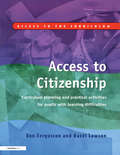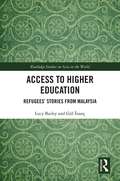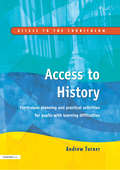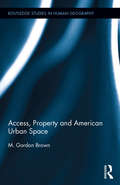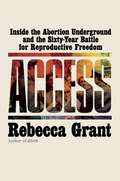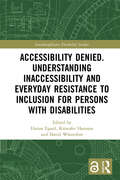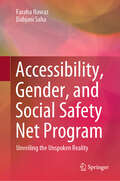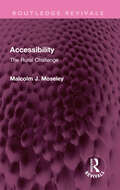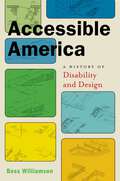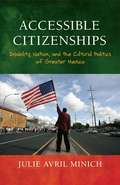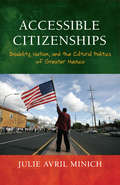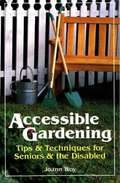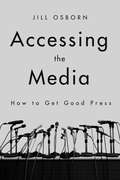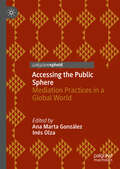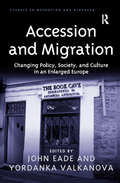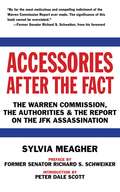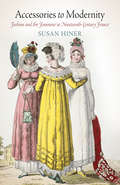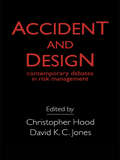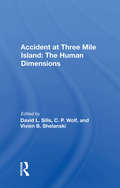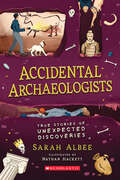- Table View
- List View
Access to Assisted Reproductive Technologies: The Case of France and Belgium (Fertility, Reproduction and Sexuality: Social and Cultural Perspectives #43)
by Jennifer MerchantDespite France and Belgium sharing and interacting constantly with similar culinary tastes, music and pop culture, access to Assisted Reproductive Technologies are strikingly different. Discrimination written into French law acutely contrasts with non-discriminatory access to ART in Belgium. The contributors of this volume are social scientists from France, Belgium, England and the United States, representing different disciplines: law, political science, philosophy, sociology and anthropology. Each author has attempted, through the prism of their specialties, to demonstrate and analyse how and why this striking difference in access to ART exists.
Access to Behavioral Health Care for Geographically Remote Service Members and Dependents in the U.S.
by Dionne Barnes-Proby Grant N. Marshall Yashodhara Rana Ryan Andrew Brown Lisa Miyashiro Coreen Farris Harold Alan Pincus Phoenix Voorhies Karen Chan Osilla Joshua Breslau Teague Ruder Katherine Pfrommer David M. AdamsonConcerns about access to behavioral health care for military service members and their dependents living in geographically remote locations prompted research into how many in this population are remote and the effects of this distance on their use of behavioral health care. The authors conducted geospatial and longitudinal analyses to answer these questions and reviewed current policies and programs to determine barriers and possible solutions.
Access to Citizenship: Curriculum Planning and Practical Activities for Pupils with Learning Difficulties (Access To The Curriculum Ser.)
by Hazel Lawson Ann FergussonThis accessible and practical teaching resource provides a basis for interpreting and accessing the national curriculum framework to include all pupils. Suggesting an inclusive framework of participation and achievement for all, the book provides *a range of possible activities designed to be accessible to pupils with diverse individual needs *reference to the P levels *help with planning and monitoring the curriculum *assessment and recording opportunities *advice on teaching citizenship in a cross-curricular way *suggestions to develop a whole-school and community approach. The book is aimed at staff in mainstream and special settings who work with students with special educational needs in the area of citizenship. This includes all class teachers, citizenship coordinators and adult learning disability services staff.
Access to Higher Education: Refugees' Stories from Malaysia (Routledge Studies on Asia in the World)
by Lucy Bailey Gül İnançUntil 2015, no refugees in Malaysia were able to access higher education, and they were unable to attend government schooling. Since then, six private higher education institutions have agreed to open their doors to refugees for the first time. This book contains stories from this small group of successful refugees, who have managed to receive higher education in a country that neither recognizes that they exist nor offers them even basic education. It identifies the factors that aided their success, and charts the challenges that they and their communities have faced. The authors present each story, based on interviews, within the context of the individual’s background and nation of origin. These stories are framed by a discussion of the situation that refugees face in accessing education globally, explaining how these stories and the methodologies used for this study are universal.
Access to History: Curriculum Planning and Practical Activities for Children with Learning Difficulties (Access To The Curriculum Ser.)
by Andrew TurnerThis accessible and practical teaching resource focuses on access to the history curriculum for pupils with learning difficulties. Within an inclusive framework of participation and achievement for all, the book provides activities designed to be accessible to pupils with diverse individual needs, guidance on the P levels, assessment and recording opportunities, and advice on teaching history in a cross-curricular way. By keeping in mind the needs of the busy practitioner, the book avoids jargon and concentrates on the real teaching opportunities.
Access to Justice and Human Security: Cultural Contradictions in Rural South Africa (Cultural Diversity and Law)
by Sindiso Mnisi WeeksFor most people in rural South Africa, traditional justice mechanisms provide the only feasible means of accessing any form of justice. These mechanisms are popularly associated with restorative justice, reconciliation and harmony in rural communities. Yet, this ethnographic study grounded in the political economy of rural South Africa reveals how historical conditions and contemporary pressures have strained these mechanisms’ ability to deliver the high normative ideals with which they are notionally linked. In places such as Msinga access to justice is made especially precarious by the reality that human insecurity – a composite of physical, social and material insecurity – is high for both ordinary people and the authorities who staff local justice forums; cooperation is low between traditional justice mechanisms and the criminal and social justice mechanisms the state is meant to provide; and competition from purportedly more effective ‘twilight institutions’, like vigilante associations, is rife. Further contradictions are presented by profoundly gendered social relations premised on delicate social trust that is closely monitored by one’s community and enforced through self-help measures like witchcraft accusations in a context in which violence is, culturally and practically, a highly plausible strategy for dispute management. These contextual considerations compel us to ask what justice we can reasonably speak of access to in such an insecure context and what solutions are viable under such volatile human conditions? The book concludes with a vision for access to justice in rural South Africa that takes seriously ordinary people’s circumstances and traditional authorities’ lived experiences as documented in this detailed study. The author proposes a cooperative governance model that would maximise the resources and capacity of both traditional and state justice apparatus for delivering the legal and social justice – namely, peace and protection from violence as well as mitigation of poverty and destitution – that rural people genuinely need.
Access to Justice in Iran
by Sahar MaranlouThis book offers a critical and in-depth analysis of access to justice from international and Islamic perspectives. Existing Western models have highlighted the mechanisms by which individuals can access justice; however, access to justice incorporates various conceptions of justice and of the users of justice. This book evaluates the historical development of the justice sector in Iran and discusses various issues, such as the performance of the justice sector, judicial independence, efficiency and accessibility, normative protection, together with an analysis of barriers. It explores the legal empowerment of users, with a specific focus on women, and presents the findings of a survey study on the perceptions of Iranian women. This study is designed to focus on women's basic legal knowledge, their familiarity with legal procedure, their perceptions of cultural barriers, the issues that influence their preference for mechanisms of formal or alternative dispute solutions, and their level of satisfaction with their chosen courses of action.
Access to Origins: Affines, Ancestors, and Aristocrats
by Mary W. HelmsIn many non-industrial, non-Western societies, power and prestige are closely linked to the extent of an individual's or group's perceived connection to the supernatural realm, which also explains and validates tangible activities such as economic success, victories in war, or control over lucrative trade. Affines (in-laws), ancestors, and aristocrats, in particular, are connected to the realm of creative cosmological origins (i. e. , to Genesis), which accords them distinctive, supernatural powers and gives them a natural and legitimate right to worldly authority. This is the hypothesis that Mary W. Helms pursues in this broadly cross-cultural study of aristocracy in chiefly societies. She begins with basic ideas about the dead, ancestors, affines, and concepts of cosmological origins. This leads her to a discussion of cosmologically defined hierarchies, the qualities that characterize aristocracy, and the political and ideological roles of aristocrats as wife-givers and wife-takers (that is, as in-laws). She concludes by considering various models that explain how societies may develop or define aristocracies. In many non-industrial, non-Western societies, power and prestige are closely linked to the extent of an individual's or group's perceived connection to the supernatural realm, which also explains and validates tangible activities such as economic success, victories in war, or control over lucrative trade. Affines (in-laws), ancestors, and aristocrats, in particular, are connected to the realm of creative cosmological origins (i. e. , to Genesis), which accords them distinctive, supernatural powers and gives them a natural and legitimate right to worldly authority. This is the hypothesis that Mary W. Helms pursues in this broadly cross-cultural study of aristocracy in chiefly societies. She begins with basic ideas about the dead, ancestors, affines, and concepts of cosmological origins. This leads her to a discussion of cosmologically defined hierarchies, the qualities that characterize aristocracy, and the political and ideological roles of aristocrats as wife-givers and wife-takers (that is, as in-laws). She concludes by considering various models that explain how societies may develop or define aristocracies.
Access, Property and American Urban Space (Routledge Studies in Human Geography #57)
by M. Gordon BrownThis book explains why the earliest cities had grid-form street systems, what conditions led to their being overwhelmingly preferred for 5000 years throughout the world, why the Founding Fathers wanted gridform cities and how they affect economic transactions. Real property has been instrumental in forming urban settlements for 5000 years, but virtually all urban form commentary, theory and research has ignored this reality. The result is an incomplete and flawed understanding of cities. Real property became a means of arranging spatial patterns caused by millennia of human evolutionary and historical developments with respect to access and movement. As a result, access to resources of all types became a regulatory mechanism controlled, at least in part, by real property ownership. The effects of real property on urban spatial patterns are currently best seen by examining American urban space, which has changed significantly over the past 200 years. This change, which began in the 1840s and established path dependence through a combination of design thought, sentimental pastoralism and financial prowess resulted in an urban regime shift that diminished economic resilience. This book offers a rethinking of how real property relates to real space, examines the thought of form promoters, links space, property, neurological evolution and settlement form, shows access is measurable and describes the plusses and minuses of functionalism, rent seeking, general purpose technology, grid-form street systems and what the American Founding Fathers thought about urban form.
Access: Inside the Abortion Underground and the Sixty-Year Battle for Reproductive Freedom
by Rebecca GrantFrom the award-winning author of Birth, a journey into the underground activist networks that have been working to protect women&’s autonomy over their bodies amidst legal, political, religious, and cultural oppression over the past sixty years.In this definitive, eye-opening history, award-winning author Rebecca Grant charts the reproductive freedom movement from the days before Roe through the seismic impact of Dobbs. The stories in Access span four continents, tracing strategies across generations and borders. Grant centers those activists who have been engaged in direct action to help people get the abortions they need. Their efforts involve no small measure of daring-do, spy craft, sea adventures, close calls, undercover operations, smuggling, sequins, legal dramas, victories, defeats, and above all, a deeply held conviction that all the risks are worth it for the cause. In Access, we meet a cast of brave, bold, and unforgettable women: the founders of the Jane Collective, a group of anonymous providers working clandestinely between Chicago apartments to perform abortions in the pre-Roe years; the originators and leaders of the abortion fund movement; Verónica Cruz Sánchez, a Mexican activist who works to support self-managed abortion with pills and fights to free women targeted by the criminalization of abortion; and Rebecca Gomperts, a Dutch doctor who realizes that there is one place abortion bans cannot reach: international waters. Post-Dobbs, activist groups have once again stepped up and put themselves on the line to resist. Building on the work of their feminist forebearers and international allies, they are charting new pathways for access in the face of unprecedented acts to subjugate and control half of America&’s population. Working above ground, underground, and in legal gray areas, they&’ve helped people travel across state lines for care, established telehealth practices, and formed community networks to distribute pills for free to people who needed them. Drawing on expert research and investigative reporting, told with deep compassion and humanity by a journalist who has spent her career on the frontlines of the fight, Access celebrates the bravery, ingenuity, and determination of women across decades who have fought for a fundamental human right—and serves as an inspiring rallying cry for the work that lies ahead.
Accessibility Denied. Understanding Inaccessibility and Everyday Resistance to Inclusion for Persons with Disabilities (Interdisciplinary Disability Studies)
by Hanna EgardThis book explores the societal resistance to accessibility for persons with disabilities, and tries to set an example of how to study exclusion in a time when numerous policies promise inclusion. With 12 chapters organised in three parts, the book takes a comprehensive approach to accessibility, covering transport and communication, knowledge and education, law and organisation. Topics within a wide cross-disciplinary field are covered, including disability studies, social work, sociology, ethnology, social anthropology, and history. The main example is Sweden, with its implementation of the United Nations Convention on the Rights of Persons with Disabilities within the context of the Nordic welfare state. By identifying and discussing persistent social and cultural conditions as well as recurring situations and interactions that nurture resistance to advancing accessibility, despite various strong laws promoting it, the book’s conclusions are widely transferable. It argues for the value of alternating between methods, theoretical perspectives, and datasets to explore how new arenas, resources and technologies cause new accessibility concerns — and possibilities — for persons living with impairments. We need to be able to follow actors closely to uncover how they feel, act, and argue, but also to connect to wider discursive and institutional patterns and systems. This book will be of interest to scholars and students of disability studies, social work, sociology, ethnology, social anthropology, political science, and organisation studies.
Accessibility, Gender, and Social Safety Net Program: Unveiling the Unspoken Reality
by Faraha Nawaz Dabjani SahaThis book offers an extensive research work to explore the accessibility of women with disabilities and financial insolvency to social safety net program in rural Bangladesh. The book examines the impact of intersectional identities in accessibility to the human rights in a contextual setting. The authors have also scrutinized the existing policies to identify policy gaps and provide some policy recommendations from this insightful study. Apart from narrower view of the targeting method or implementation of social safety net program on targeting beneficiaries, this research has combined gender and disability in a study framework with making a focus on the Allowances Program for Insolvent Persons with Disabilities provided by Government of Bangladesh. They have argued that intersectional identities (gender, disability, financial insolvency) have influenced over the accessibility to social safety net program as well as identified the challenges of accessibility which provides a broader view of practices of public administration of Bangladesh and enlightens on social and cultural context creating barriers in accessibility to human rights of women with disabilities. The authors argue for bringing changes of the service delivery of the program by bringing change in policies according to human right-based treaties. This book is useful to policy makers, international donor agencies, government officials, and NGOs.
Accessibility: The Rural Challenge (Routledge Revivals)
by Malcolm J. MoseleyOriginally published in 1979, this book discusses the problem faced by planners, county councils, transport, health and education authorities as well as the inhabitants of rural Britain, of the inaccessibility of many areas of the UK. For certain sections of society such as the less well-off, children and teenagers and the elderly the impact is felt most strongly when local shops, schools and medical services are withdrawn in favour of larger units in distant towns. The book reviews the process of decline which led to this situation and considers the concept of accessibility to show how it can be developed into an analytical tool for measuring the success or failure of alternative policies. Each policy option is discussed in detail: the support of conventional bus or other transport services; the provision of mobile services; ‘mini-outlet’ policies and the long-term restructuring of the rural settlement pattern.
Accessible America: A History of Disability and Design (Crip #2)
by Bess WilliamsonA history of design that is often overlooked—until we need itHave you ever hit the big blue button to activate automatic doors? Have you ever used an ergonomic kitchen tool? Have you ever used curb cuts to roll a stroller across an intersection? If you have, then you’ve benefited from accessible design—design for people with physical, sensory, and cognitive disabilities. These ubiquitous touchstones of modern life were once anything but. Disability advocates fought tirelessly to ensure that the needs of people with disabilities became a standard part of public design thinking. That fight took many forms worldwide, but in the United States it became a civil rights issue; activists used design to make an argument about the place of people with disabilities in public life.In the aftermath of World War II, with injured veterans returning home and the polio epidemic reaching the Oval Office, the needs of people with disabilities came forcibly into the public eye as they never had before. The US became the first country to enact federal accessibility laws, beginning with the Architectural Barriers Act in 1968 and continuing through the landmark Americans with Disabilities Act in 1990, bringing about a wholesale rethinking of our built environment. This progression wasn’t straightforward or easy. Early legislation and design efforts were often haphazard or poorly implemented, with decidedly mixed results. Political resistance to accommodating the needs of people with disabilities was strong; so, too, was resistance among architectural and industrial designers, for whom accessible design wasn’t “real” design.Bess Williamson provides an extraordinary look at everyday design, marrying accessibility with aesthetic, to provide an insight into a world in which we are all active participants, but often passive onlookers. Richly detailed, with stories of politics and innovation, Williamson’s Accessible America takes us through this important history, showing how American ideas of individualism and rights came to shape the material world, often with unexpected consequences.
Accessible Citizenships: Disability, Nation, and the Cultural Politics of Greater Mexico
by Julie Avril MinichAccessible Citizenships examines Chicana/o cultural representations that conceptualize political community through images of disability. Working against the assumption that disability is a metaphor for social decay or political crisis, Julie Avril Minich analyzes literature, film, and visual art post-1980 in which representations of non-normative bodies work to expand our understanding of what it means to belong to a political community. Minich shows how queer writers like Arturo Islas and Cherríe Moraga have reconceptualized Chicano nationalism through disability images. She further addresses how the U. S. -Mexico border and disabled bodies restrict freedom and movement. Finally, she confronts the changing role of the nation-state in the face of neoliberalism as depicted in novels by Ana Castillo and Cecile Pineda. Accessible Citizenships illustrates how these works gesture towards less exclusionary forms of citizenship and nationalism. Minich boldly argues that the corporeal images used to depict national belonging have important consequences for how the rights and benefits of citizenship are understood and distributed.
Accessible Citizenships: Disability, Nation, and the Cultural Politics of Greater Mexico
by Julie Avril MinichAccessible Citizenships examines Chicana/o cultural representations that conceptualize political community through images of disability. Working against the assumption that disability is a metaphor for social decay or political crisis, Julie Avril Minich analyzes literature, film, and visual art post-1980 in which representations of non-normative bodies work to expand our understanding of what it means to belong to a political community. Minich shows how queer writers like Arturo Islas and Cherríe Moraga have reconceptualized Chicano nationalism through disability images. She further addresses how the U.S.-Mexico border and disabled bodies restrict freedom and movement. Finally, she confronts the changing role of the nation-state in the face of neoliberalism as depicted in novels by Ana Castillo and Cecile Pineda. Accessible Citizenships illustrates how these works gesture towards less exclusionary forms of citizenship and nationalism. Minich boldly argues that the corporeal images used to depict national belonging have important consequences for how the rights and benefits of citizenship are understood and distributed. A volume in the American Literatures Initiative
Accessible Gardening: Tips And Techniques For Seniors And The Disabled
by Joann WoyIf advancing age, illness, or accident has made gardening too difficult for you, don't become frustrated. There is an alternative. Accessible Gardening is a book of tips and techniques that will help you to overcome obstacles and return the joy of gardening to your life: recommendations for modifying an existing garden for gardening ease; advice on selecting ergonomic tools and low-maintenance plants; directions for constructing raised-bed planters; instructions for developing manageable watering and pest-control systems; specifications for paths, inclines, and railings; discussion on the psychological and physical benefits of gardening.
Accessing the Media: How to Get Good Press
by Jill OsbornAccessing the Media takes the reader behind the scenes to understand how best to work with press to get publicity. Perfect for politicians, business leaders, lobbyists, and media junkies, this reference provides an insider's look at how the modern newsroom works, detailing the different roles of reporters, editors, and producers. Readers will learn how to forge relationships with media personnel in television, radio, print, and the web to craft the press coverage they want.Award-winning journalist Jill Osborn exposes the three strategic steps that must be used to gain favorable coverage with the media at just the right time. She gives you the inside scoop on how to think like a national or local journalist so you can control the headlines. And she even provides sample press releases to help shape your message. When reading Accessing the Media, you will have a personal media consultant without the cost of hiring one.Whether you are running for office, looking to improve visibility for your business, or simply want a deeper understanding of what you see and read in the news, Accessing the Media is the perfect guide to getting your story out to the world.
Accessing the Public Sphere: Mediation Practices in a Global World
by Ana Marta González Inés OlzaThis edited volume focuses on the (un)equal access to the public space granted to the various groups that make up hybrid and multicultural societies: i.e. majority vs minority groups, immigrants vs non-immigrants, and so forth. With ‘access to public space’ the authors refer not only to participation through discursive practices in the public arena (e.g. political, social and institutional debates) but also to a full operationalization of the knowledge, habits and opportunities attached to true citizenship. Furthermore, in contexts of inequality and sociocultural conflict, the role of mediators has always been underscored as third-party figures (in)formally acknowledged and authorized–by participants in the interaction and/or external bodies–to set the ground for mutual understanding and foster balanced communication. Such mediation can range from interpreting in legal and medical encounters to dispute-resolution practices in situations of sociocultural clash among groups or individuals. Therefore, as is shown by the contributions in this volume, (intercultural) mediators are key agents in facilitating integration and providing disadvantaged groups with effective tools to gain access to the public sphere.
Accession and Migration: Changing Policy, Society, and Culture in an Enlarged Europe (Studies in Migration and Diaspora)
by Yordanka ValkanovaThe expansion of the European Union in May 2004 through the entry of ten countries from Central and Eastern Europe, has generated considerable media interest - interest which was revived by further expansion in January 2007 when Bulgaria and Romania became the latest nations from the east to join. Rather than focus exclusively on changes within the EU labour market and related policy debates, this book offers a careful, grounded analysis of the social and cultural processes bound up with migration flows between Britain and Bulgaria, placing these flows in the wider European perspective. As such, Accession and Migration will be of interest not only to migration scholars but also to policy makers at local, national and international levels.
Accessories After the Fact: The Warren Commission, the Authorities & the Report on the JFK Assassination
by Peter Dale Scott Richard S. Schweiker Sylvia MeagherOriginally published in 1967, Meagher's masterful dissection of the Warren Report, based on the Warren Commission's own evidence, has stood the test of time. In some cases, declassifications of government records have corroborated the author's suspicions and analyses, such as her amazing assertion that Oswald had never actually been charged with Kennedy's murder, despite sworn testimony to the contrary. Meagher's book raises serious questions not only about Oswald's guilt in the JFK assassination and related crimes, such as the Tippit murder and the Walker shooting, but also about the methods and honesty of the Warren Commission, the FBI, and various Dallas police and other officials.When the Church Committee first began to re-examine the Warren Commission and its relationship with intelligence agencies in 1975, investigators were shocked by what they discovered. In Accessories After the Fact, Sylvia Meagher delivers a blistering blow to the credibility of the Warren Report, and decades after its original publication researchers and readers are still discovering what made her work so important.
Accessories to Modernity: Fashion and the Feminine in Nineteenth-Century France
by Susan HinerAccessories to Modernity explores the ways in which feminine fashion accessories, such as cashmere shawls, parasols, fans, and handbags, became essential instruments in the bourgeois idealization of womanhood in nineteenth-century France. Considering how these fashionable objects were portrayed in fashion journals and illustrations, as well as fiction, the book explores the histories and cultural weight of the objects themselves and offers fresh readings of works by Balzac, Flaubert, and Zola, some of the most widely read novels of the period.As social boundaries were becoming more and more fluid in the nineteenth century, one effort to impose order over the looming confusion came, in the case of women, through fashion, and the fashion accessory thus became an ever more crucial tool through which social distinction could be created, projected, and maintained. Looking through the lens of fashion, Susan Hiner explores the interplay of imperialist expansion and domestic rituals, the assertion of privilege in the face of increasing social mobility, gendering practices and their relation to social hierarchies, and the rise of commodity culture and woman's paradoxical status as both consumer and object within it.Through her close focus on these luxury objects, Hiner reframes the feminine fashion accessory as a key symbol of modernity that bridges the erotic and proper, the domestic and exotic, and mass production and the work of art while making a larger claim about the "accessory" status—in terms of both complicity and subordination—of bourgeois women in nineteenth-century France. Women were not simply passive bystanders but rather were themselves accessories to the work of modernity from which they were ostensibly excluded.
Accident And Design: Contemporary Debates On Risk Management
by Christopher Hood David K. C. JonesAn examination of different theoretical, methodological and practical approaches towards the management of risk. Seven dimensions of the debate are identified, and the case for each position is put forward, the whole discussion being set in context and perspective. This volume attempts to identify and juxtapose the contested doctrines and underlying assumptions in the field of risk management.
Accident At Three Mile Island: The Human Dimensions
by David L. Sills C. P. Wolf Vivien B. ShelanskiThe nuclear accident at Three Mile Island in March 1979 was as much a social-systems failure as it was an engineering failure. It raised questions not only about the regulation and management of nuclear-power plants but also about the effects of nuclear accidents on the community, on society, and on the total controversy surrounding nuclear energy. Questions were also raised about public perceptions of the risks of high technology. At the request of the President's Commission on the Accident at Three Mile Island (the Kemeny Commission), the Social Science Research Council commissioned social scientists to write a series of papers on the human dimensions of the event. This volume includes those papers, in revised and expanded form, and a comprehensive bibliography of published and unpublished social science research on the accident and its aftermath.
Accidental Archaeologists: True Stories of Unexpected Discoveries
by Sarah AlbeeScience meets real-life mystery in this adventurous look at incredible unexpected finds that changed history.Secret treasures are buried all around us -- you just have to look for them!Accidental Archaeologists takes you on an adventure through time to relive some of the coolest surprise discoveries by totally ordinary people all over the world. Meet:- The cowboy who found an ancient skeleton- A famous king buried underneath a parking lot- The team who found New York City's hidden African Burial Ground- A boy who finds the Dead Sea Scrolls while looking for his lost goat- And many more.Packed with incredible stories and expert tips for making your own exciting finds, this is an accessible, action-packed introduction to the world of archaeology.


